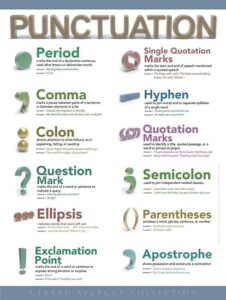 Tomorrow is National Punctuation Day. If you’ve read this far, you’re likely already following the rules. I’m preaching to the choir and I know it. But here goes anyway.
Tomorrow is National Punctuation Day. If you’ve read this far, you’re likely already following the rules. I’m preaching to the choir and I know it. But here goes anyway.
This column isn’t about spelling or grammar or word choice or sentence structure or how to grab hold of your reader and never let go. It’s about those 12 little symbols—apostrophe, colon, comma, dash, ellipsis, exclamation point, hyphen, parentheses, period, question mark, quotation mark and semicolon—that help writing make sense. I’m not sure who said this, but I like it: Proper punctuation is a road map to literacy. Space limitations keep me from writing about all the punctuation marks or from going into detail about any of them, so I’ve chosen the ones I consider most important or most frequently misunderstood.
Let’s start with semicolons. They’re used to join two independent clauses without a coordinating conjunction. The last time I used a semicolon was in high school, or maybe before that. Two separate sentences are easier and almost always better. Colons, on the other hand, are one of my favorite punctuation marks. They introduce a list or direct attention to what follows the colon or help write what time it is in numerals rather than words. Useful, indeed.
Periods are easy. They bring a sentence to a full stop or indicate that some information has been removed, as in abbreviations or initials. Question marks are even easier. See?
But exclamation points are tricky. They’re designed to show strong emotion or excitement: Fire! Halt! Run, Forrest, run! The problem with exclamation points is that they’re easy to overuse. Overuse makes them ineffective. When confronted with too many exclamation points in a piece of writing, be it a Facebook post or a 1,000-page novel, a reader at first tends to ignore or overlook them. Then the reader becomes annoyed. Finally, he or she concludes—and rightfully so–that the writer is a rank amateur. The best rule for using exclamation points? When in doubt, don’t.
I’m hesitant to write about commas here because they really deserve a column all their own. Comma rules are many and complicated. One thing commas do is separate items in a list. Example: The colors in the American flag are red, white and blue. But wait. Shouldn’t I have typed a comma after the word “white”? Not if I’m writing for this newspaper, which doesn’t use the Oxford comma. In some other publications, the Oxford comma is not only acceptable but required. See what I mean? Complicated. Let’s move on.
I saved the hardest one for last. Apostrophes, those cute little punctuation marks that look like commas hanging in the air, give lots of writers fits. They’re frequently used when someone wants to make a word plural. For example, more than one truck might be written as truck’s. That’s wrong. To make a noun (even a proper noun) plural, in most cases all you have to do is add “s.” Sometimes “es.” But NEVER an apostrophe.
So what if you want to write about the tires on a truck? You write “the truck’s tires.” (If more than one truck, “the trucks’ tires.”) The apostrophe in these cases is possessive, meaning the tires belong to the trucks. Things get trickier when you use possessive pronouns. Never use an apostrophe when writing his, hers, its, theirs, ours or yours. “Its” is the word that causes the most confusion. Don’t use an apostrophe when writing “The tree lost its leaves in October” because “its” is possessive. But if you write “It’s going to be bare all winter,” do use an apostrophe because “it’s” is a contraction for “it is.” And there’s no such word as “its’.” I promise.
Punctuation isn’t always simple, but it’s important. And if you know why I used an apostrophe in that “it’s,” good job paying attention. And Happy Punctuation Day! (That exclamation point is both deliberate and, I believe, appropriate.)
(September 23, 2023)